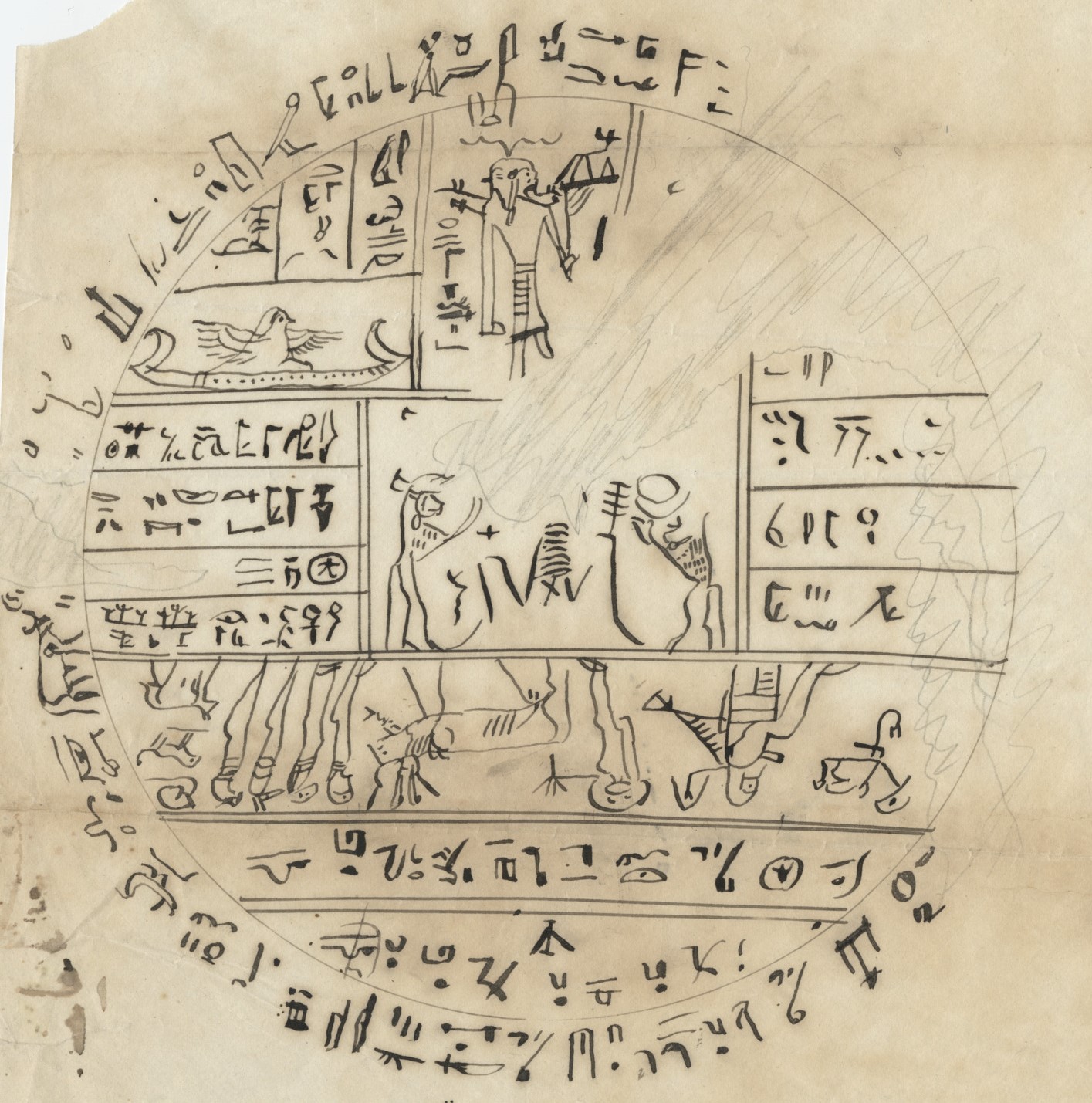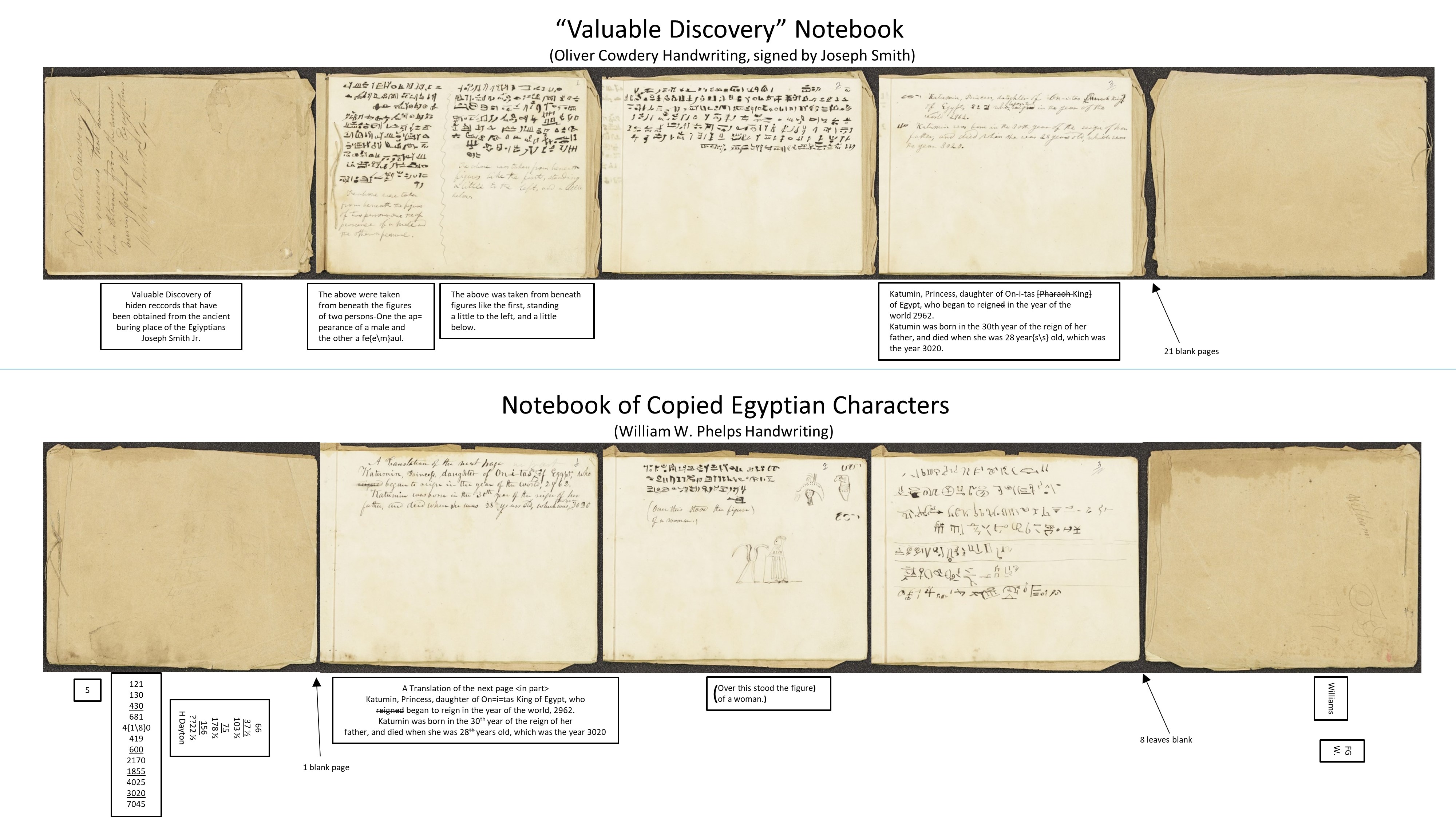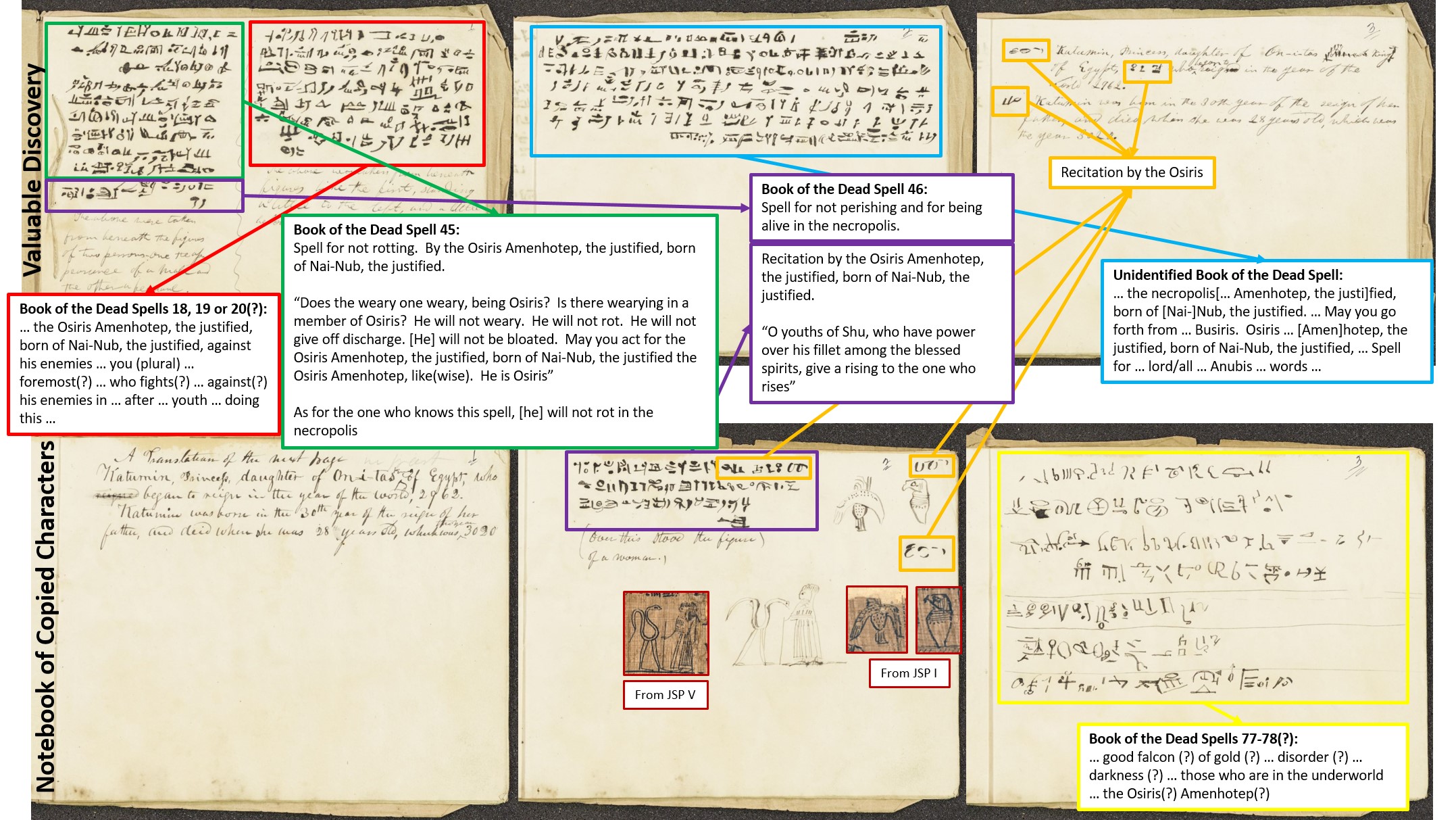Egyptian Alphabet And Grammar on:
[Wikipedia]
[Google]
[Amazon]
 The Kirtland Egyptian papers (KEP) are a collection of documents related to the
The Kirtland Egyptian papers (KEP) are a collection of documents related to the

 When Michael Chandler arrived in Kirtland in 1835 with the Egyptian Papyri, he allowed Oliver Cowdery to copy "four or five different sentences" from the papyri. A translation of the lines by Joseph Smith were given to Michael Chandler to his satisfaction. Given that the "Valuable Discovery" notebook was written in Oliver Cowdery's hand, signed by Joseph Smith, with a translation of some of the characters, it is postulated that it is the same notebook.Jensen, Robin Scott, and Brian M. Hauglid, eds. Revelations and Translations, Volume 4: Book of Abraham and Related Manuscripts. Facsimile edition. Vol. 4 of the Revelations and Translations series of The Joseph Smith Papers, edited by Ronald K. Esplin, Matthew J. Grow, Matthew C. Godfrey, and R. Eric Smith. Salt Lake City: Church Historian’s Press, 2018. page 25
When Michael Chandler arrived in Kirtland in 1835 with the Egyptian Papyri, he allowed Oliver Cowdery to copy "four or five different sentences" from the papyri. A translation of the lines by Joseph Smith were given to Michael Chandler to his satisfaction. Given that the "Valuable Discovery" notebook was written in Oliver Cowdery's hand, signed by Joseph Smith, with a translation of some of the characters, it is postulated that it is the same notebook.Jensen, Robin Scott, and Brian M. Hauglid, eds. Revelations and Translations, Volume 4: Book of Abraham and Related Manuscripts. Facsimile edition. Vol. 4 of the Revelations and Translations series of The Joseph Smith Papers, edited by Ronald K. Esplin, Matthew J. Grow, Matthew C. Godfrey, and R. Eric Smith. Salt Lake City: Church Historian’s Press, 2018. page 25
 Most of the copied Egyptian characters in either notebook were untranslated by Smith or his associates.
Some of the characters are translated to read "Katumin, Princess, daughter of On-i-tas King of Egypt, who began to reign in the year of the world 2962. Katumin was born in the 30th year of the reign of her father and died when she was 28 years old which was in the year 3020." The Egyptian Hieratic characters have been translated by modern Egyptologists to read "Recitation by the Osiris".
The name Onitas appears in other Kirtland Egyptian manuscripts, and Joseph Smith's mother would later state that the mummies were "King Onitus and his royal household."
Most of the copied Egyptian characters in either notebook were untranslated by Smith or his associates.
Some of the characters are translated to read "Katumin, Princess, daughter of On-i-tas King of Egypt, who began to reign in the year of the world 2962. Katumin was born in the 30th year of the reign of her father and died when she was 28 years old which was in the year 3020." The Egyptian Hieratic characters have been translated by modern Egyptologists to read "Recitation by the Osiris".
The name Onitas appears in other Kirtland Egyptian manuscripts, and Joseph Smith's mother would later state that the mummies were "King Onitus and his royal household."
WilliamPhelpsSampleOfPureLanguage.jpg , Sample of Pure Language, in a letter from William W. Phelps to his wife Sally on May 26, 1835, written one month prior to the arrival of the Papyri
PureLanguageCharactersFromEgyptianAlphabetA.jpg, Section of Egyptian Alphabet-A in Joseph Smith's handwriting, with pure language characters
The Egyptian Alphabet
from The Joseph Smith Papers (accessed December 17, 2016)
Book of Abraham manuscript materials
from The Joseph Smith Papers (accessed December 17, 2016) Pearl of Great Price (Mormonism) Criticism of Mormonism Works by Joseph Smith Latter Day Saint movement in Ohio Kirtland, Ohio Book of Abraham
 The Kirtland Egyptian papers (KEP) are a collection of documents related to the
The Kirtland Egyptian papers (KEP) are a collection of documents related to the Book of Abraham
The Book of Abraham is a collection of writings claimed to be from several Egyptian scrolls discovered in the early 19th century during an archeological expedition by Antonio Lebolo. Members of the Church of Jesus Christ of Latter-day Saints pu ...
created in Kirtland between July and November 1835, and Nauvoo between March through May 1842. Because some documents were created in Nauvoo, the collection is sometimes referred to as the ''Book of Abraham and Related Manuscripts'' and ''Joseph Smith Egyptian Papers''.
The papers include an "Egyptian alphabet" written in the hand of Joseph Smith
Joseph Smith Jr. (December 23, 1805June 27, 1844) was an American religious leader and founder of Mormonism and the Latter Day Saint movement. When he was 24, Smith published the Book of Mormon. By the time of his death, 14 years later, ...
, other Egyptian language
The Egyptian language or Ancient Egyptian ( ) is a dead Afro-Asiatic language that was spoken in ancient Egypt. It is known today from a large corpus of surviving texts which were made accessible to the modern world following the decipher ...
related materials and early manuscript versions of the Book of Abraham in the handwriting of Oliver Cowdery
Oliver H. P. Cowdery (October 3, 1806 – March 3, 1850) was an American Mormon leader who, with Joseph Smith, was an important participant in the formative period of the Latter Day Saint movement between 1829 and 1836. He was the first baptized ...
, W. W. Phelps, Warren Parish
Warren F. Parrish (January 10, 1803 – January 3, 1877) was a leader in the early Latter Day Saint movement. Parrish held a number of positions of responsibility, including that of scribe to church president Joseph Smith. Parrish and other leader ...
, Willard Richards
Willard Richards (June 24, 1804 – March 11, 1854) was a physician and midwife/nurse trainer and an early leader in the Latter Day Saint movement. He served as second counselor to church president Brigham Young in the First Presidency of th ...
, and Frederick G. Williams.
The papers have been a source of controversy, because the translations and interpretations within are not considered accurate by Egyptologists
This is a partial list of Egyptologists. An Egyptologist is any archaeologist, historian, linguist, or art historian who specializes in Egyptology, the scientific study of Ancient Egypt and its antiquities. Demotists are Egyptologists who special ...
, and have thus stoked questions of whether the Book of Abraham
The Book of Abraham is a collection of writings claimed to be from several Egyptian scrolls discovered in the early 19th century during an archeological expedition by Antonio Lebolo. Members of the Church of Jesus Christ of Latter-day Saints pu ...
is a literal translation of the Joseph Smith Papyri
The Joseph Smith Papyri (JSP) are Egyptian funerary papyrus fragments from ancient Thebes dated between 300 to 100 BC which, along with four mummies, were once owned by Joseph Smith, the founder of the Latter Day Saint movement. Smith said that ...
. Some apologists of the Church of Jesus Christ of Latter-day Saints
The Church of Jesus Christ of Latter-day Saints, informally known as the LDS Church or Mormon Church, is a nontrinitarian Christian church that considers itself to be the restoration of the original church founded by Jesus Christ. The ch ...
(LDS Church) have postulated that many of the papers may have been produced by Smith's scribes without his involvement, and that they may have been intended as a speculative or naturalistic effort rather than a product of revelation.
Content
The Kirtland Egyptian papers are housed in theChurch History Library
The Church History Library (CHL) is a research center and archives building housing materials chronicling the history of the Church of Jesus Christ of Latter-day Saints (LDS Church). The library is owned by the Church and opened in 2009 in downt ...
of the LDS Church. They comprise over a dozen other documents produced ca. 1835 and 1842 in Kirtland, Ohio
Kirtland is a city in Lake County, Ohio, United States. The population was 6,937 at the 2020 census. Kirtland is known for being the early headquarters of the Latter Day Saint movement from 1831 to 1837 and is the site of the movement's first t ...
, and Nauvoo, Illinois. All dates for production are estimates. Due to controversy about the order of production, there is no generally accepted manuscript numbering scheme. The manuscript numbers (MS #) reported below refer to the folder numbers under which the manuscripts are catalogued in the Church archives. These folder numbers were assigned by Hugh Nibley ca. 1971. The order given below mirrors the authoritative Joseph Smith Papers
''The Joseph Smith Papers'' (or Joseph Smith Papers Project) is a project researching, collecting, and publishing all manuscripts and documents created by, or under the direction of, Joseph Smith (1805-1844), the founder of the Latter Day Saint ...
project.
Notebooks of Copied Egyptian Characters
 When Michael Chandler arrived in Kirtland in 1835 with the Egyptian Papyri, he allowed Oliver Cowdery to copy "four or five different sentences" from the papyri. A translation of the lines by Joseph Smith were given to Michael Chandler to his satisfaction. Given that the "Valuable Discovery" notebook was written in Oliver Cowdery's hand, signed by Joseph Smith, with a translation of some of the characters, it is postulated that it is the same notebook.Jensen, Robin Scott, and Brian M. Hauglid, eds. Revelations and Translations, Volume 4: Book of Abraham and Related Manuscripts. Facsimile edition. Vol. 4 of the Revelations and Translations series of The Joseph Smith Papers, edited by Ronald K. Esplin, Matthew J. Grow, Matthew C. Godfrey, and R. Eric Smith. Salt Lake City: Church Historian’s Press, 2018. page 25
When Michael Chandler arrived in Kirtland in 1835 with the Egyptian Papyri, he allowed Oliver Cowdery to copy "four or five different sentences" from the papyri. A translation of the lines by Joseph Smith were given to Michael Chandler to his satisfaction. Given that the "Valuable Discovery" notebook was written in Oliver Cowdery's hand, signed by Joseph Smith, with a translation of some of the characters, it is postulated that it is the same notebook.Jensen, Robin Scott, and Brian M. Hauglid, eds. Revelations and Translations, Volume 4: Book of Abraham and Related Manuscripts. Facsimile edition. Vol. 4 of the Revelations and Translations series of The Joseph Smith Papers, edited by Ronald K. Esplin, Matthew J. Grow, Matthew C. Godfrey, and R. Eric Smith. Salt Lake City: Church Historian’s Press, 2018. page 25
Copies of Egyptian Characters
Egyptian Alphabet Documents
The three Egyptian Alphabet documents created by Joseph Smith and his associates are an attempt to systematize the Egyptian language. Much like a dictionary, there are columns with the character, pronunciation and the definition of the character. The documents are incomplete, with many of the characters lacking definitions. Some of the characters do not come from the Papyri, but from what Joseph Smith told William W. Phelps were Adamic language characters.Grammar and Alphabet of the Egyptian Language
Authorship controversy
Egyptologist I. E. S. Edwards stated that the Egyptian Alphabet and Grammar was "largely a piece of imagination and lacking in any kind of scientific value." Hugh Nibley commented that the Grammar was "of no practical value whatever." In 1968, Jay Todd suggested that the Grammar may have been reverse-engineered from an inspired Book of Abraham translation. In 1971, Hugh Nibley expanded on Todd's argument, explaining that the Alphabet and Grammar materials were largely an uninspired production of Joseph Smith's scribes, who had turned against him and were working independently of him at the time. This view is also accepted by John Gee. Samuel M. Brown has argued for a slightly more nuanced version of this view, attributing to W. W. Phelps a "major" role in authoring the Alphabet and Grammar, while at the same time conceding that the project was carried on under Smith's direction. Brown asserts that it is "unlikely, though not impossible, that the Grammar was actively used in producing the Book of Abraham." In 1970, Richard P. Howard proposed the opposite view: that the Alphabet and Grammar was the ''modus operandi'' of the Book of Abraham's translation. Edward H. Ashment has also adopted this view, arguing against Nibley that the scribes of the KEP were all loyal to and in good standing with Joseph Smith at the time the manuscripts were produced. More recently, Christopher C. Smith has argued at some length that Joseph Smith was the primary author of the Alphabet and Grammar documents, and that those documents served as the source or ''modus operandi'' for the translation of at least the first three verses of the Book of Abraham. According to Smith, "This undoubtedly accounts for the choppiness and redundancy of these three verses, which stylistically are very different from the remainder of the Book of Abraham. Verse 3, for example, reads as though it has been cobbled together from a series of dictionary entries."Book of Abraham Manuscripts circa July-circa November 1835
Publication
The LDS Church has been accused of suppressing the Kirtland Egyptian Papers because they were considered potentially damaging to the credibility of Joseph Smith, Jr. as a prophet. The Papers have been in the Church Historian and Recorder's vault inSalt Lake City
Salt Lake City (often shortened to Salt Lake and abbreviated as SLC) is the capital and most populous city of Utah, United States. It is the seat of Salt Lake County, the most populous county in Utah. With a population of 200,133 in 2020, th ...
since 1855, and there are indications that the Church Historians have been aware of the documents' whereabouts since 1908. Their existence was denied until 1935, when James R. Clark and Sidney B. Sperry Sidney Branton Sperry (December 26, 1895 – September 4, 1977) was one of three scholars who were members of the Church of Jesus Christ of Latter-day Saints (LDS Church) who began the scholarly and systematic study of the Book of Mormon in the mid- ...
were informed that they were in the vault. Even then, Clark and Sperry were not permitted to inform the public about the discovery until some time thereafter. When the documents' existence was finally revealed, Clark stated that he did not believe the Alphabet and Grammar should be submitted to scholars. He preferred to "depend on our testimonies of the gospel."
Jerald and Sandra Tanner
Jerald Dee Tanner (June 1, 1938 – October 1, 2006) and Sandra McGee Tanner (born January 14, 1941) are American writers and researchers who publish archival and evidential materials about the history of the Church of Jesus Christ of Latter-day Sa ...
, critics of the Church, obtained an unauthorized copy of a microfilm
Microforms are scaled-down reproductions of documents, typically either photographic film, films or paper, made for the purposes of transmission, storage, reading, and printing. Microform images are commonly reduced to about 4% or of the origin ...
strip containing images of the documents in 1966, and published them as ''Joseph Smith's Egyptian Alphabet & Grammar''. This publication was criticized in a ''BYU Studies'' article by Hugh Nibley in 1971 because it did not contain all of the manuscripts, and included no critical apparatus to aid readers in distinguishing one manuscript from another. Nibley's article included images of ten of the manuscript pages.Nibley, "Meaning of the Kirtland Egyptian Papers." The Tanner publication was revised and updated by H. Michael Marquardt in 1981. Marquardt added a critical apparatus and some interpretive material.H. Michael Marquardt, ''The Joseph Smith Egyptian Papers'', (Cullman, Ala.: Printing Service, 1981). A new critical edition of the Book of Abraham manuscripts by Brian M. Hauglid appeared in 2011, with a second volume planned to publish the remainder of the KEP.
On October 29, 2018, the Joseph Smith Papers
''The Joseph Smith Papers'' (or Joseph Smith Papers Project) is a project researching, collecting, and publishing all manuscripts and documents created by, or under the direction of, Joseph Smith (1805-1844), the founder of the Latter Day Saint ...
project released all existing documents relating to the creation of the Book of Abraham, including high resolution images of all the Egyptian Papyri, KEPs, and Nauvoo papers.
See also
*Reformed Egyptian
The Book of Mormon, a work of scripture of the Latter Day Saint movement, describes itself as having a portion originally written in reformed Egyptian characters on plates of metal or "ore" by prophets living in the Western Hemisphere from perha ...
*Book of Abraham
The Book of Abraham is a collection of writings claimed to be from several Egyptian scrolls discovered in the early 19th century during an archeological expedition by Antonio Lebolo. Members of the Church of Jesus Christ of Latter-day Saints pu ...
*Criticism of the Book of Abraham
The Book of Abraham is a work produced between 1835 and 1842 by the Latter Day Saints (LDS) movement founder Joseph Smith that he said was based on Egyptian papyri purchased from a traveling mummy exhibition. According to Smith, the book was "a ...
* Joseph Smith Hypocephalus
*The Joseph Smith Papers
''The Joseph Smith Papers'' (or Joseph Smith Papers Project) is a project researching, collecting, and publishing all manuscripts and documents created by, or under the direction of, Joseph Smith (1805-1844), the founder of the Latter Day Saint ...
*Joseph Smith Papyri
The Joseph Smith Papyri (JSP) are Egyptian funerary papyrus fragments from ancient Thebes dated between 300 to 100 BC which, along with four mummies, were once owned by Joseph Smith, the founder of the Latter Day Saint movement. Smith said that ...
* Kolob
Notes
External links
{{Wikisource, Grammar & Alphabet of the Egyptian LanguageThe Egyptian Alphabet
from The Joseph Smith Papers (accessed December 17, 2016)
Book of Abraham manuscript materials
from The Joseph Smith Papers (accessed December 17, 2016) Pearl of Great Price (Mormonism) Criticism of Mormonism Works by Joseph Smith Latter Day Saint movement in Ohio Kirtland, Ohio Book of Abraham